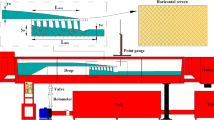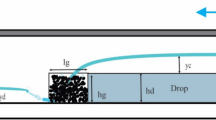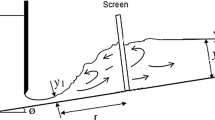Abstract
One of the most effective ways to dissipate the destructive energy of water downstream of a flow control structure is the interference of water with air (such as a vertical drop). In this study, the hydraulic parameters of a vertical drop equipped with dual horizontal screens and with the subcritical upstream flow were investigated. Experiments were performed for two drop heights, two porosities, three relative distances between the screens, and a relative critical depth that was varied from 0.077 to 0.242. The results revealed that the relative distance between the screens does not affect the relative depth and downstream residual energy. On the other hand, increasing the relative length of the drop caused a decrease in the relative depth. Also, for a vertical drop equipped with a type 1 settling basin, the relative downstream depth decreased by more than 48%. The normal residual downstream energy and the relative total length of the drop are also decreased. The results also reveal that the use of dual horizontal screens transformed the regime of flow from super- to subcritical downstream of the drop.









Similar content being viewed by others
Abbreviations
- S p :
-
distance between the screens (m)
- P :
-
porosity of screens (dimensionless)
- h :
-
drop height (m)
- Q :
-
flow discharge (m3 s−1)
- g :
-
gravitational acceleration (m s−2)
- y c :
-
critical depth (m)
- y u :
-
approach flow depth (m)
- y d :
-
downstream depth of the drop(m)
- y p :
-
back pool depth (m)
- L wet :
-
wetted length of the screen (m)
- L mix :
-
mixing length of pool (m)
- E d :
-
specific energy of drop downstream (m)
- E u :
-
total energy of drop upstream (m)
- α :
-
relative critical depth (dimensionless)
- S pr :
-
relative distance between screens (dimensionless)
- Y p :
-
relative pool depth (dimensionless)
- Y d :
-
relative downstream depth (dimensionless)
- L w :
-
relative wetted length (dimensionless)
- L m :
-
mixing length (dimensionless)
- E d :
-
normalized residual energy (dimensionless)
- Ψ :
-
relative reduction percentage pool depth (dimensionless)
- Ypd:
-
pool depth for vertical drop equipped with double horizontal screens (m)
- Y ps :
-
pool depth for vertical drop equipped with a single horizontal screen (m)
- L d :
-
drop length (m)
- L b :
-
length of the hydraulic jump (m)
- L sm :
-
relative length of plain vertical drop (m)
- ω :
-
ratio of increasing the relative downstream depth (dimensionless)
- Yd d :
-
relative downstream depth of the plain vertical drop (m)
- Yd s :
-
relative downstream depth of vertical drop equipped with double horizontal screens (m)
References
Aslankara V (2007) Experimental investigation of tailwater effect on the energy dissipation through screens. Doctoral dissertation, MS thesis, Middle East Technical Univ. Ankara, Turkey
Bakhmeteff MW (1932) Hydraulics of open channels. McGraw-Hill book company, Inc, New York
Bradley JN, Peterka AJ (1957) The hydraulic design of stilling basins: hydraulic jumps on a horizontal apron (basin i). J Hydraul Div 83(5):1–24
Çakir P (2003) Experimental investigation of energy dissipation through screens. Doctoral dissertation, M. Sc. Thesis, Department of Civil Engineering, Middle East Technical University, Ankara, Turkey
Chamani MR, Rajaratnam N, Beirami MK (2008) Turbulent jet energy dissipation at vertical drops. J Hydraul Eng 134(10):1532–1535
Daneshfaraz R, Sadeghfam S, Ghahramanzadeh A (2017) Three-dimensional numerical investigation of flow through screens as energy dissipators. Can J Civil Eng 44(10):850–859
Daneshfaraz R, Sadeghfam S, Tahni A (2019) Experimental investigation of screen as energy dissipators in the movable-bed channel. Iran J Sci Tech Trans Civil Eng. https://doi.org/10.1007/s40996-019-00306-7
Esen II, Alhumoud JM, Hannan KA (2004) Energy loss at a drop structure with a step at the base. Water Int 29(4):523–529
Farouk M, Elgamal M (2012) Investigation of the performance of single and multi-drop hydraulic structures. Int J Hydrol Sci Technol 2(1):48–74
Gill MA (1979) Hydraulics of rectangular vertical drop structures. J Hydraul Res 17(4):289–302
Hasanniya V (2019) Experimental investigation of flow energy dissipation through the application of the screen in drops. MS thesis, Civil Engineering Department, Faculty of Engineering, University of Maragheh, Maragheh, Iran
Hong YM, Huang HS, Wan S (2010) Drop characteristics of free-falling nappe for an aerated straight-drop spillway. J Hydraul Res 48(1):125–129
Kabiri-Samani AR, Bakhshian E, Chamani MR (2017) Flow characteristics of grid drop-type dissipators. Flow Meas Instrum 54:298–306
Liu SI, Chen JY, Hong YM, Huang HS, Raikar RV (2014) Impact characteristics of free over-fall in pool zone with upstream bed slope. J Mar Sci Technol 22(4):476–486
Norouzi R, Daneshfaraz R, Bazyar A (2019) The study of energy dissipation due to the use of vertical screen in the downstream of inclined drops by adaptive neuro-fuzzy inference system (ANFIS). Amirkabir J Civil Eng. https://doi.org/10.22060/CEEJ.2019.16694.6305
Rajaratnam N, Chamani MR (1995) Energy loss at drops. J Hydraul Res 33(3):373–384
Rajaratnam N, Hurtig KI (2000) Screen-type energy dissipator for hydraulic structures. J Hydraul Eng 126(4):310–312
Rouse H (1936) Discharge characteristics of the free overfall: use of crest section as a control provides easy means of measuring discharge. Civil Eng 6(4):257–260
Sadeghfam S, Akhtari AA, Daneshfaraz R, Tayfur G (2015) Experimental investigation of screens as energy dissipaters in the submerged hydraulic jump. Turk J Eng Environ Sci 38(2):126–138
Sadeghfam S, Daneshfaraz R, Khatibi R, Minaei O (2019) Experimental studies on scour of supercritical flow jets in upstream of screens and modelling scouring dimensions using artificial intelligence to combine multiple models (AIMM). J Hydroinf 21(5):893–907
Sharif M, Kabiri-Samani A (2018) Flow regimes at grid drop-type dissipators caused by changes in tail-water depth. J Hydraul Res 56(4):505–516
Acknowledgements
The authors wish to thank all who assisted in conducting this work.
Author information
Authors and Affiliations
Corresponding author
Additional information
Editorial responsibility: M. Abbaspour.
Rights and permissions
About this article
Cite this article
Daneshfaraz, R., Majedi Asl, M., Razmi, S. et al. Experimental investigation of the effect of dual horizontal screens on the hydraulic performance of a vertical drop. Int. J. Environ. Sci. Technol. 17, 2927–2936 (2020). https://doi.org/10.1007/s13762-019-02622-x
Received:
Revised:
Accepted:
Published:
Issue Date:
DOI: https://doi.org/10.1007/s13762-019-02622-x




